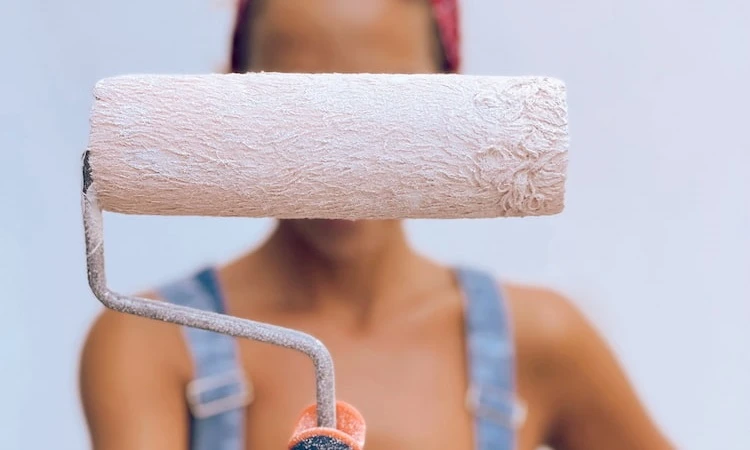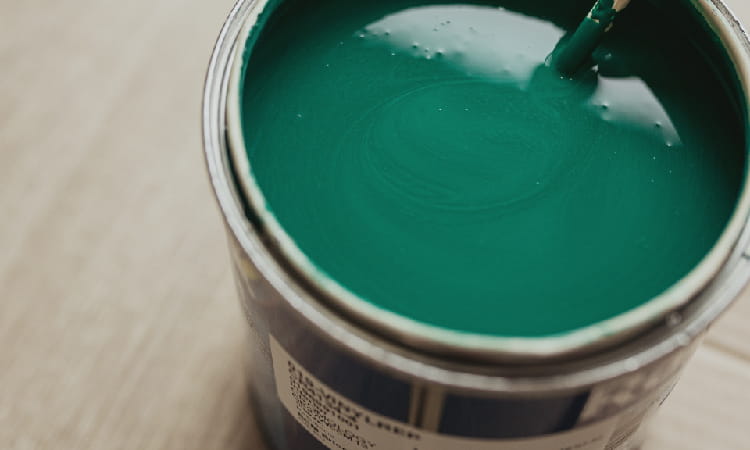You’ve just concluded your outdoor painting job, but you still have a half-full gallon of paint left.
Then, you realize your kitchen walls also need repainting. It sounds like a good idea for this project, but can you use exterior paint inside?
Exterior paints adhere well to any surface, and some users express that they work better than interior paints.
However, they produce toxic fumes that make people sick. They contain a high amount of volatile organic compounds (VOCs). You may use them inside, but you need to understand the risks.
It is my goal that you know the composition of exterior paint and understands the risks associated with using it indoors. I will also discuss its key features.
Moreover, I will explore the possibility of using the paint on various surfaces, such as front doors, garages, and bathrooms.
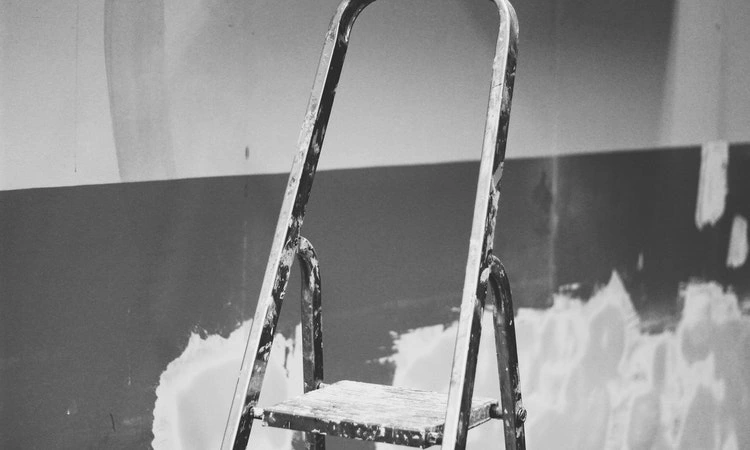
What is Exterior Paint?
Exterior paints are formulated for use on outdoor surfaces such as walls, fences, benches, and porches.
They contain high VOCs, making them not ideal for indoor use. Inhalation of these toxic fumes may cause dizziness, vomiting, or other illnesses.
Exterior paints can withstand changing elements such as wind, rain, mildew, snow, and sunlight.
They are durable enough to last between 7 to 10 years when properly applied. If your priority is durability, you can’t go wrong with exterior paints.
Key Features of Exterior Paints
Below are the key characteristics of exterior paints. You can check each item to help you decide whether to use it to paint the inside of your house or not.
They can withstand harsh weather conditions. The formulation includes anti-fading properties and UV protection.
You don’t have to worry so much about your paint fading, flaking, or chalking. Exterior paints resist these issues.
- Exterior paints can resist the growth of mildew that makes the paint weaker and causes cracking and flaking.
- Exterior paints are also resilient to temperature as it uses softer resins. It makes it resist cracking when the surface expands or contracts.
- They are not prone to peeling and crumbling. Exterior paints are very elastic due to their composition. They do not easily crumble or peel.
- They are water-resistant, so exposure to frequent rain is okay. A splash of water will not have any effect on your paint. You can even wash your walls regularly.
- They feature more additives, such as biocides, to avoid bacterial growth. Additives make the paint stronger and more durable.
- Exterior paints contain a high amount of VOCs that harm your health when inhaled. This characteristic makes the paint not an ideal choice for indoor painting jobs.
Can You Use Exterior Paint Inside?
Because of the promising performance of exterior paints, such as being weather-proof and durable, many people have considered using them for indoor projects.
It makes perfect sense to think about using this paint inside because of its long life span. However, is it possible?
Of course, it is possible to use exterior paint for indoor painting jobs. But the question is: Is it safe for you and your family?
You must have figured it out by now. This paint produces toxic fumes that could cause health issues, especially for those with pre-existing conditions.
Some people think that exterior paints stop releasing harmful fumes as soon as they dry up. This understanding is not correct.
Exterior paints continue to produce toxic fumes even after they dry up. However, it may be lower than when it was wet.
Therefore, using exterior paint is a matter of preference. Technical-wise, it may perform better than interior paint in terms of durability.
However, I insist you use the correct type of paint to avoid possible health risks. There is a purpose why it is considered “exterior paint.”
Using Acrylic Exterior Paint Inside
Depending on the base solvent, exterior paints can be latex (water-based) or acrylic (oil-based). Before discussing using acrylic exterior paint inside, let me first present how it differs from latex.
- They are chemical-based, so they are more elastic than water-based paints.
- They produce more harmful fumes than latex paints.
- They can be harder to clean due to some chemical reactions.
- They are more durable than latex paints.
Now, let’s go back to using acrylic exterior paint indoors.
Although I have already pointed out the health risks of using exterior paint for enclosed areas, you may still consider using it to paint some spaces in the house, such as your garage or bathroom.
So, let’s continue to discuss how oil-based paints perform when used indoors.
I have already presented the advantages of using acrylic paint above. They remain even when you use the paint for your indoor painting job.
You will rarely experience cracking or flaking issues when using exterior paint inside because it has better elasticity. It can withstand changing temperatures.
Acrylic paints are more durable than latex. However, it is also usually more expensive than the latter. Durability comes with a price.
Using Latex Exterior Paint Inside
If you prefer latex exterior paints for your indoor painting job, here are a few things you need to know.
- Latex paints are easier to clean than acrylic paints.
- They dry up faster, allowing you to use the space again in a short period.
- They are way cheaper than oil-based paints, making them the ideal choice if you are painting huge areas.
- Water-based paints are safer for use as they produce fewer fumes.
- You may need to topcoat latex paints to improve their durability.
So these were the benefits of using latex exterior paint for your indoor paint job. Similar to acrylic paints, they work well on any surface.
They are also less expensive than oil-based paints. However, you might need a clear-coat sealer to ensure durability.
Latex exterior paints still produce fumes that are risky to human health, and because the formulation is for exterior, they contain more VOCs than latex interior paints.
Reasons Why Using Exterior Paint Inside Isn’t Advisable
Let me further elaborate on why you should not use exterior paints inside. The main reason is the health risks associated with the toxic fume they produce.
Apart from that, they are prone to scuffs and scratches. They are also not economical.
I have expanded on these reasons below to provide you with more understanding of why using exterior paint inside your house is not advisable.
Related Read: Interior Paint vs. Exterior Paint: Full Comparison
1. Exterior Paints Produce Toxic Fumes
The toxins that exterior paints release can potentially cause health issues. These include breathing difficulty, runny nose, itchy eyes, and others.
The toxins can get into your body and can trigger other health conditions.
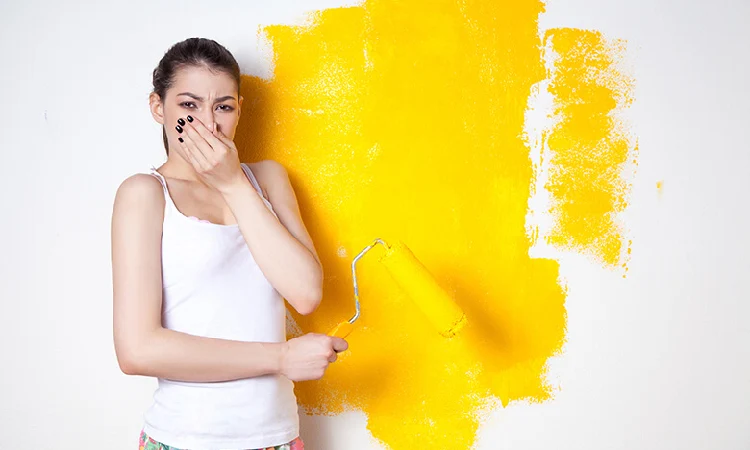
You already learned that exterior paints contain many additives. One of them is the ingredient that prevents the growth of mildew, which can cause foul odors leading to allergic reactions.
You don’t want to get sick because of choosing the wrong paint, do you?
Additionally, exterior paints continue to produce harmful toxins even after they dry. Now that is alarming! If you live with kids or old folks, you should choose the correct option.
Exterior paints are not only harmful to humans. They also have some adverse effects on the environment. The VOCs that vaporize can damage the earth’s ozone layer.
For this reason, the United States Environmental Protection Agency (EPA) regulates the use of VOCs.
2. Exterior Paints Are Not Highly Resistant to Scuffs and Scratches
There is always a motion going on inside your house. You move things, your children play around, and your pets sometimes get bored and do crazy things.
These events could expose your paint to scuffs and scratches. Exterior paint is thinner and can easily suffer from these ugly marks.
In other words, you might not be happy looking at your walls full of scratches after a few days or months of using exterior paint inside.
So, think again. Is it worth it to use exterior over interior paint? It is only you who can answer the question.
If you are a perfectionist, exterior paint is not the best option for you to paint the inside of your house.
You should use interior paint as it is thicker and it effectively resists scratches and scuffs. Plus, they do not produce a high amount of toxic fumes.
3. Exterior Paints Are Not Easy To Clean
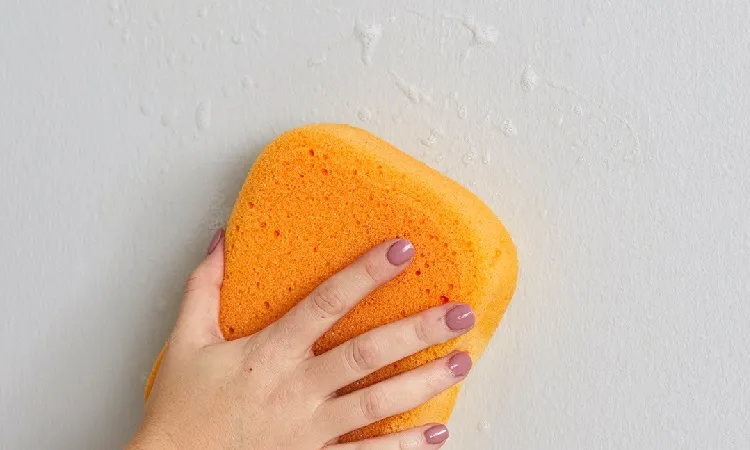
Exterior paints are oil-based, making them hard to clean them. Water and ordinary soap will not do the job.
Thus, it is more expensive to maintain as you will need to buy costly cleaning agents. It can also be overly messy to remove the paint during repainting jobs.
If you have not tried removing exterior paint, you will find the job very taxing.
Sometimes, you must use scrubs or sandpaper to get it off the surface. Additionally, you would need to use solvent to remove it completely.
When exterior paint gets dirty and ugly-looking, some people will choose not to clean it off. Instead, they do a touch-up painting. It means painting over existing paint with the same color to make it look beautiful again.
4. Exterior Paints are Inferior in Terms of Aesthetics
The inner paint of your house always greets guests. If you paint for decoration or aesthetic purposes, exterior paint is not your best option.
It doesn’t give you the ability to obtain beautiful and smooth finishes like what you get when using interior paints.
Exterior paint is better than interior in terms of durability as it can endure harsh weather conditions.
But if you are painting inside your house, the paint would not have much exposure to these weather elements.
Therefore, you don’t need to worry so much about the durability issue.
5. They Are Not Pocket-Friendly
Exterior paints are more expensive than interior paints. The additional ingredients that boost their performance make the price difference.
If you are painting a huge area inside your home, you need a bigger budget if you want to use exterior paint.
You must not forget about the toxins that exterior paints produce. These harmful fumes can cause some health conditions, which means more expenses for medication.
I always believe in the saying, “prevention is better than cure,” or should I say, “prevention is less costly than cure.”
When it comes to cleaning, it can also be expensive as you cannot use ordinary soap and water.
Plus, it may expose you to harmful chemicals because you need cleaning solvents such as paint thinners. These solvents can also potentially cause health issues.
Related Read: Can You Use Interior Paint Outside and Why
Can Use of Exterior Paint On Interior Surfaces Be Dangerous?
I guess you already know that exterior paints pose health threats. A study on the adverse health effects of VOCs reveals that these toxic fumes can cause respiratory, anaphylactic, and cardiovascular diseases.
To some extent, it can even cause or trigger cancer instances.
As mentioned earlier, EPA regulates the use of VOCs on products, and paint is one of the most common. As they are regulated, they are not safe for humans and the environment.
Exterior paints contain plenty of them, and it makes them dangerous.
The effect of the toxic fumes the exterior paints produce may not appear right away. But when they build up inside your body, they cause alarming health issues.
Therefore, avoiding exposure to these toxins is the best move. You will inhale the toxins if you use exterior paint inside.
What To Do If You Accidentally Used Exterior Paint Inside the House?
If you did not intend to use exterior paint inside the house, you would have to decide. If you realize that you are using the wrong paint at an earlier stage of your painting job, you can choose to clean up the paint while it is still wet.
However, if you realize it late, you can ask yourself the following questions: Which part of the house did I paint? Does the painted area expose the people in the house to the paint’s toxins?
Can I afford to remove the paint and buy interior paint to redo the job?
If no people frequently visit or stay in the area painted with exterior paint, it might be wise to leave the paint alone.
However, if you want to ensure safety and avoid exposure to the paint’s toxins, you can decide to remove the paint completely.
Removing the exterior paint can be a taxing job. Plus, you would spend more to purchase interior paint, and the repainting process also requires a great amount of effort.
Then again, your family’s health should be first on your list.
Using Exterior Paint Inside: FAQs
1. Can you use exterior paint inside a garage?
There is no doubt that exterior paint performs better than interior paint. The garage is one place in the house that you don’t want to repaint too often.
Those who have tried using exterior paint for their garage have shared that it lasted for almost 10 years.
2. Can you use exterior paint on the inside of your front door?
You can use exterior paint on the inside of your door, but it is not advisable. Aside from the fume it produces, it is not scratch-proof.
If you have pet dogs, they love to scratch doors to get out. Thus, your door paint can get prematurely ugly.
3. Can you use exterior paint inside your bathroom?
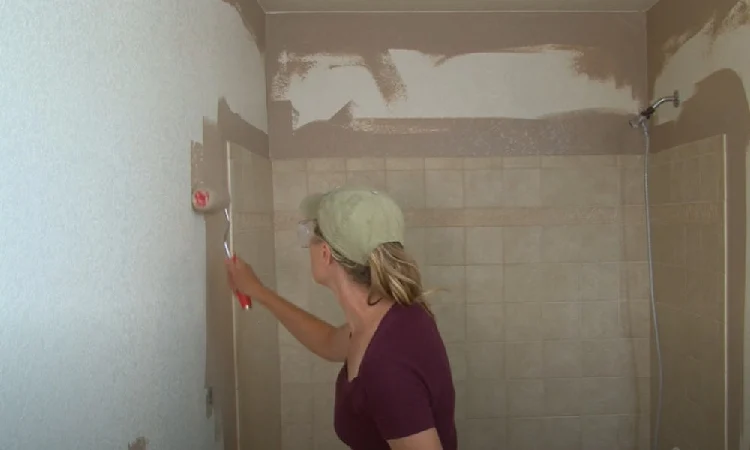
Bathrooms are the most humid places in the house. Exterior paint is not the best option for bathrooms because it has less capability to withstand frequent exposure to water than interior paint.
If you decide to use it, ensure that you apply a primer for the paint to adhere well.
4. Can you use exterior paint inside your shed?
Exterior paint can be the perfect choice for your shed. People have used it to paint theirs, and they are satisfied with the result.
You don’t spend so much time inside the shed, so the toxic fume issue is not much of a big deal.
To Sum Up
Exterior paints are durable and weatherproof. They last longer compared to interior paints. They can bear changing temperatures.
Additionally, they are not prone to crumbling or peeling, and they are elastic. They are also water-resistant, and they contain anti-mildew properties. All in all, they perform better.
However, using them to paint the inside of your house could be dangerous because these paints produce toxic fumes that can make people sick.
The toxins are also not environment-friendly. Therefore, you need to think twice before considering using this paint inside.
You can probably consider using exterior paint inside your garage or shed, as the exposure to harmful toxins is minimal. Still, it would be better to avoid using it whenever possible. Do not compromise your and your family’s health.

